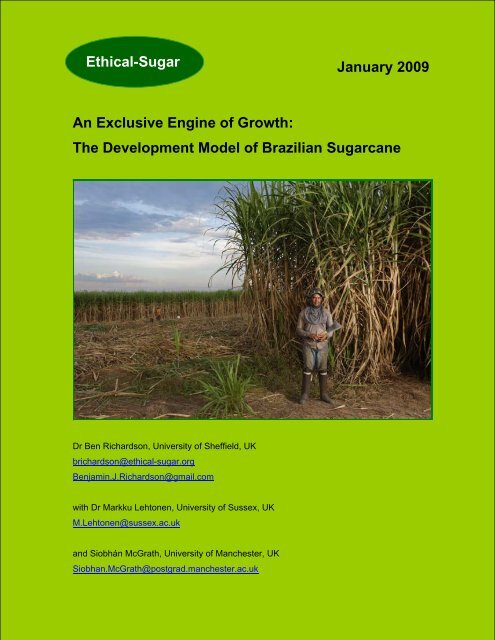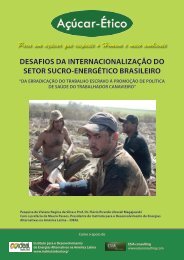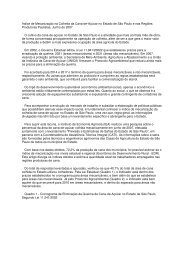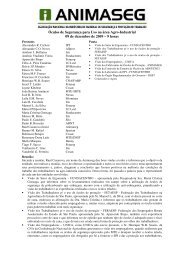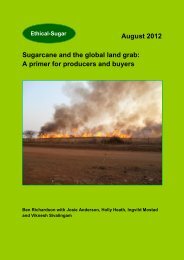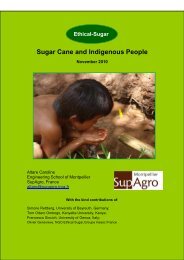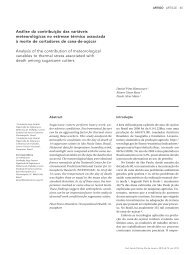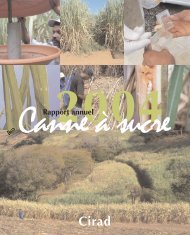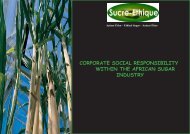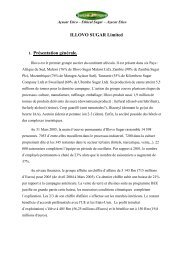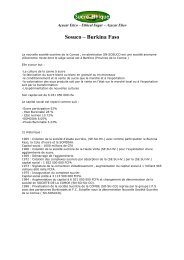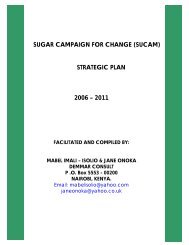The Development Model of Brazilian Sugarcane - Sucre Ethique
The Development Model of Brazilian Sugarcane - Sucre Ethique
The Development Model of Brazilian Sugarcane - Sucre Ethique
You also want an ePaper? Increase the reach of your titles
YUMPU automatically turns print PDFs into web optimized ePapers that Google loves.
Ethical-Sugar January 2009<br />
An Exclusive Engine <strong>of</strong> Growth:<br />
<strong>The</strong> <strong>Development</strong> <strong>Model</strong> <strong>of</strong> <strong>Brazilian</strong> <strong>Sugarcane</strong><br />
Dr Ben Richardson, University <strong>of</strong> Sheffield, UK<br />
brichardson@ethical-sugar.org<br />
Benjamin.J.Richardson@gmail.com<br />
with Dr Markku Lehtonen, University <strong>of</strong> Sussex, UK<br />
M.Lehtonen@sussex.ac.uk<br />
and Siobhán McGrath, University <strong>of</strong> Manchester, UK<br />
Siobhan.McGrath@postgrad.manchester.ac.uk
2<br />
Contents<br />
About the Authors p. 3<br />
About Ethical Sugar p. 4<br />
1. Introduction p. 5<br />
2. Ethanol-Led Expansion p. 6<br />
<strong>The</strong> Scope <strong>of</strong> Production<br />
3. Consolidation, Modernisation and <strong>Development</strong> Dualism p. 12<br />
<strong>The</strong> Mode <strong>of</strong> Production<br />
4. Bringing the Landless Back In p. 27<br />
<strong>The</strong> Borders <strong>of</strong> Production<br />
5. Conclusion p. 32<br />
Ethicl
3<br />
About the Authors<br />
Dr Ben Richardson has recently completed his PhD on the role <strong>of</strong> power in shaping<br />
accumulation in the international sugar industry. He is the author <strong>of</strong> ‘Restructuring the<br />
EU-ACP Sugar Regime: Out <strong>of</strong> the Strong there Came Forth Sweetness’ awaiting<br />
publication in the journal Review <strong>of</strong> International Political Economy and ‘Path<br />
Dependency and the Politics <strong>of</strong> Liberalisation in the Textile and Clothing Industry’ (with<br />
Tony Heron) in New Political Economy, Vol. 13, No.1. He is also the UK representative<br />
<strong>of</strong> Ethical Sugar.<br />
An early version <strong>of</strong> this paper was given at the Historical Materialism conference held at<br />
SOAS University from 7-9 November 2008. Since then, the author has received<br />
significant contributions from Markku Lehtonen and Siobhán McGrath and would like to<br />
thank them for their considered advice in developing this paper.<br />
Dr Markku Lehtonen is a Research Fellow in the Science and Technology Policy<br />
Research group at Sussex. His current research includes projects on technological<br />
innovation in bi<strong>of</strong>uels and an EU-funded study into the policy influence <strong>of</strong> sustainability<br />
and environmental indicators. His recent publications include ‘Social Sustainability <strong>of</strong> the<br />
<strong>Brazilian</strong> Bioethanol: Power Relations in a Centre-Periphery Perspective’ awaiting<br />
publication in the journal Biomass and Bioenergy and ‘Mainstreaming Sustainable<br />
<strong>Development</strong> in the OECD through Indicators and Peer Reviews’ in Sustainable<br />
<strong>Development</strong>, Vol. 16, No. 4.<br />
Siobhán McGrath is a PhD candidate working on the political economy <strong>of</strong> forced labour<br />
in Brazil. She has recently completed fieldwork in the country, looking in particular at the<br />
sugar and garment industries, and her publications include ‘Social Reproduction as<br />
Unregulated Work’ (with James Defilippis) in a forthcoming edition <strong>of</strong> Work, Employment<br />
and Society and ‘Stitching Together a Movement? Three Works about Globalization, the<br />
Apparel Industry, and Anti-Sweatshop Activism’ in Antipode, No. 38.<br />
Ethicl
4<br />
About Ethical Sugar<br />
This research was undertaken for Ethical Sugar, an NGO that seeks to enhance<br />
dialogue within the sugar-ethanol industry with a view to improving its social and<br />
environmental development. 1 Trade unions, companies, civil society activists and<br />
academics are all brought together as part <strong>of</strong> this dialogue, which allows Ethical Sugar to<br />
construct a more rounded vision <strong>of</strong> the different situations and positions that pertain in<br />
the industry and facilitate a multipartite form <strong>of</strong> Corporate Social Responsibility.<br />
<strong>The</strong> recent growth in ethanol consumption is seen as an opportunity to affect this CSR<br />
as corporations in different countries are brought closer together through the influx <strong>of</strong><br />
foreign direct investment, on the one hand, and the creation <strong>of</strong> new supply chains to<br />
export fuel, on the other. Ethical Sugar believe that as consumers come to recognise the<br />
close links forged across national boundaries, it is incumbent upon producing companies<br />
to surpass minimal legal standards <strong>of</strong> production and lay down a long-term strategy to<br />
avoid negative publicity and reassure their partners about their business ethics. In<br />
mature markets such as the EU or North America, this strategy has a longer history and<br />
typically invokes a strong element <strong>of</strong> social monitoring.<br />
1 http://www.sucre-ethique.org/Corporate-social-responsability<br />
Ethicl
5<br />
1. Introduction<br />
This paper provides a contemporary and critical assessment <strong>of</strong> the development being<br />
fostered in the <strong>Brazilian</strong> sugarcane industry. It looks in particular at the effects that the<br />
rapid expansion, modernisation and consolidation <strong>of</strong> the industry have had on labour<br />
and peasants in the country – groups <strong>of</strong> people <strong>of</strong>ten overlooked in a debate marked<br />
more by global environmental and food security concerns – and <strong>of</strong>fers three key insights.<br />
First, it maps out the markets into which sugarcane has been sold, and through this<br />
shows how the discourse <strong>of</strong> environmentalism and food security have fed into state<br />
rhetoric on the industry and in doing so deflected attention away from the employment<br />
and self-sufficiency <strong>of</strong> the rural poor. Second, it illustrates the active role that state elites<br />
played in facilitating the growth <strong>of</strong> the industry and suggests how corporate<br />
concentration and ‘knowledge-driven productivity’ have accelerated during the<br />
succeeding gold rush <strong>of</strong> domestic and foreign investment. Third, it reveals how this<br />
particular confluence <strong>of</strong> factors has created a kind <strong>of</strong> ‘development dualism’, whereby<br />
the fractions <strong>of</strong> relatively skilled labour are benefiting but many others, including<br />
peasants, have lost out. It notes, also, how this dualism has had a regional manifestation<br />
as the expansion <strong>of</strong> sugarcane and potential next generation bi<strong>of</strong>uels risks reinforcing<br />
the disparities between the country’s prosperous Centre-South and the stagnant and<br />
technologically less developed Northeast. In sum, we show why the <strong>Brazilian</strong> sugarcane<br />
industry should thus be considered an exclusive engine <strong>of</strong> growth.<br />
<strong>The</strong> purpose <strong>of</strong> this discussion paper is exactly that: to stimulate discussion and to<br />
provide the concepts and arguments necessary for civil society to demand that state<br />
<strong>of</strong>ficials, industry associations, and individual companies find ways to make the benefits<br />
<strong>of</strong> the industry less exclusive. We consider that the distribution <strong>of</strong> the benefits <strong>of</strong><br />
economic growth remains a resolutely social and political question. It is partly for this<br />
reason that we maintain a degree <strong>of</strong> scepticism about the ability <strong>of</strong> certification and<br />
standards setting schemes to insulate actors in the industry from wider questions about<br />
income equality and power imbalances. While these schemes – such as the Better<br />
<strong>Sugarcane</strong> Initiative for example, <strong>of</strong> which Ethical Sugar is a member – are apt to ensure<br />
that the industry enhances its sustainability across a range <strong>of</strong> indicators, they are unable<br />
to fully account for those producers who refuse to sign up to the letter or spirit <strong>of</strong> the<br />
protocol, and, perhaps more importantly, account for those people, like the newly<br />
Ethicl
6<br />
unemployed or peasants, who have been ring-fenced outside the industry. 2 <strong>The</strong><br />
dialogue <strong>of</strong> development should be an ongoing one and it is important to remember that,<br />
while they are important tools <strong>of</strong> change, certification schemes cannot exhaust this<br />
debate. We hope that this paper will encourage the informed opinion and political<br />
mobilisation necessary to engage in this debate and help reshape, through constructive<br />
dialogue, the model <strong>of</strong> development in the industry.<br />
2. Ethanol-led Expansion: <strong>The</strong> Scope <strong>of</strong> Production<br />
Since the turn <strong>of</strong> the 20 th century, Brazil has experienced unprecedented growth rates in<br />
cane production. Between 2001 and 2008, cane output increased 11% year on year, the<br />
highest among all major sugarcane producers. 3 A common reaction has been to see this<br />
as ‘good growth’ twice over. Not only does it constitute the relocation <strong>of</strong> tropical<br />
commodity production to a developing country, thus correcting the imbalance caused by<br />
years <strong>of</strong> developed country protectionism, but it also delivers significant global<br />
environmental benefits, given that the ethanol produced from <strong>Brazilian</strong> sugarcane<br />
generates less CO 2 emissions than petrol and other sources <strong>of</strong> bi<strong>of</strong>uel. Indeed, the<br />
country’s President, Luiz Inácio Lula da Silva, has constantly been on stump to make<br />
such points. 4<br />
We begin by disaggregating this recent sales boom in order to find out a little more about<br />
the characteristics <strong>of</strong> the individual sugar and ethanol markets – both products, <strong>of</strong> course,<br />
which can be processed from the sugarcane plant. Up until 2006, additional planting in<br />
cane was evenly split between sugar and ethanol production, building on the country’s<br />
already sizeable raw and refined sugar output. Such has been the scale <strong>of</strong> this<br />
increased planting that Brazil has now come to dominate the world trade in sugar. As<br />
UNCTAD have noted, since 1995, while the structure <strong>of</strong> the world sugar market on the<br />
import side has remained fairly constant at around 0.115 (with 1 representing a perfect<br />
monopoly and 0 representing an equal distribution <strong>of</strong> market share), on the export side<br />
2 For more on the limits <strong>of</strong> certification, see the ‘Call for an Immediate Moratorium on EU<br />
Incentives for Agr<strong>of</strong>uels, EU Imports <strong>of</strong> Agr<strong>of</strong>uels and EU Agroenergy Monocultures’ by a host <strong>of</strong><br />
environmental and Global South NGOs. Available at Hwww.econexus.info/bi<strong>of</strong>uels.htmlH<br />
3 Leonardo Bichara Rocha, ‘Brazil’s <strong>Sugarcane</strong> Output Growth: Current Drivers and Outlook’,<br />
International Sugar Organization Market Report, 2008, p. 2.<br />
4 Luiz Inácio Lula da Silva, ‘Join Brazil in Planting Oil’, <strong>The</strong> Guardian, 7 March 2006.<br />
Ethicl
7<br />
there has been significant structural change. 5 In 1995, the concentration index stood at<br />
0.197 but by 2005 it had grown to 0.224, essentially due to <strong>Brazilian</strong> exports. As Figure 1<br />
reveals, these exports increased over 500% during the period in question.<br />
Figure 1: International Sugar Trade, 1994-2005<br />
Largest Exporters, million tones<br />
Largest Importers, million tonnes<br />
1994 2000 2005 1994 2000 2005<br />
Australia<br />
4.52<br />
Brazil<br />
6.50<br />
Brazil<br />
18.40<br />
India<br />
2.63<br />
Russia<br />
5.23<br />
Russia<br />
3.57<br />
Brazil<br />
3.60<br />
EU<br />
6.20<br />
EU<br />
6.66<br />
Russia<br />
1.96<br />
EU<br />
1.90<br />
EU<br />
2.42<br />
EU<br />
3.26<br />
Thailand<br />
4.34<br />
Australia<br />
4.24<br />
Japan<br />
1.70<br />
Japan<br />
1.61<br />
USA<br />
2.07<br />
Cuba<br />
3.19<br />
Australia<br />
3.77<br />
Thailand<br />
3.31<br />
China<br />
1.24<br />
Indonesia<br />
1.56<br />
Indonesia<br />
2.00<br />
Thailand<br />
2.72<br />
Cuba<br />
3.42<br />
Guatemala<br />
1.57<br />
USA<br />
1.13<br />
Korea<br />
1.46<br />
Algeria<br />
1.92<br />
Source: International Sugar Organisation, Statistical Bulletin, Vol. 60, No. 11, 2001, p. iii and Vol. 65, No. 12,<br />
2006, p. iii.<br />
One <strong>of</strong> the most interesting things about the reshaping <strong>of</strong> global sugar supply is that it<br />
has come about in the absence <strong>of</strong> any significant liberalisation in trade. Although the<br />
commodity was brought into the remit <strong>of</strong> the World Trade Organisation in 1995, market<br />
access continues to be tightly controlled. To illustrate, in the 12 years since the Uruguay<br />
Round <strong>of</strong> trade talks was concluded, imports <strong>of</strong> sugar as a percentage <strong>of</strong> consumption<br />
increased by only 0.3%. 6 <strong>The</strong> dominance <strong>of</strong> Brazil on the world market, then, came not<br />
through a decline in protectionism but rather because <strong>of</strong> expanding demand for raw<br />
sugar by refineries in the Middle East, and falling output from the traditional heavyweight<br />
exporter Cuba (and since 2007, the EU too).<br />
5 UNCTAD, Handbook <strong>of</strong> Statistics, 2006-07 (Geneva: UNCTAD, 2007), pp. 185-191.<br />
6 In 2007, imports <strong>of</strong> sugar as a percentage <strong>of</strong> consumption was 33%. F. O. Licht, International<br />
Sugar and Sweetener Report, 1998/99-2007/08 (F. O. Licht: Ratzeburg, Germany, 2008), pp. 4-8.<br />
Ethicl
in mind. 7 Figure 2: <strong>Brazilian</strong> Ethanol Production, 1997-2007<br />
8<br />
Not only did the volume <strong>of</strong> exported sugar from Brazil increase, so did its value.<br />
Responding to shortages brought on by rising demand for sugar in Asia and crop failure<br />
in Thailand and Australia, sugar prices were bid up sharply during 2005. Another crucial<br />
component <strong>of</strong> this price rise was the increasing diversion <strong>of</strong> cane into the domestic<br />
ethanol market in Brazil for had this cane been processed into sugar and exported into<br />
the world sugar market, it would have significantly dampened prices. While the<br />
production <strong>of</strong> <strong>Brazilian</strong> ethanol for export has arguably received the most press<br />
coverage, it is in fact the domestic market that has been driving demand, as illustrated in<br />
Figure 2 below. In fact, so rapid has this sales rise been that the vast majority <strong>of</strong> new<br />
sugarcane planted is now done so with the ethanol market rather than the sugar market<br />
25<br />
20<br />
Billion Litres<br />
15<br />
10<br />
5<br />
0<br />
1997 1998 1999 2000 2001 2002 2003 2004 2005 2006 2007<br />
Domestic Consumption<br />
Exports<br />
Source: Leonardo Bichara Rocha, ‘Brazil’s Sugar and Ethanol Industries’, International Sugar Organization<br />
Presentation, 25 September 2008, slide 18.<br />
<strong>The</strong> expansion in domestic ethanol demand was triggered by the introduction <strong>of</strong> the<br />
“flex-fuel” cars in the <strong>Brazilian</strong> market in 2002. In contrast to the traditional ‘gasohol’<br />
vehicles which could only take up to 20-25% added anhydrous ethanol, flex-fuel vehicles<br />
7 In 2006 3.1m ha were dedicated to sugar production and 3.1m ha to ethanol. By 2018, this is<br />
project to increase to 4.1m ha to sugar production and 7.7m ha to ethanol. See Andre Meloni<br />
Nassar et al., ‘Prospects <strong>of</strong> the <strong>Sugarcane</strong> Expansion in Brazil: Impacts on Land Use Allocation<br />
and Changes’, Presentation by the Institute for International Trade Negotiations at the Chatham<br />
House Bi<strong>of</strong>uels Roundtable, London, 14-15 April 2008, slide 6.<br />
Ethicl
9<br />
can take any percentage <strong>of</strong> ethanol, thus vastly increasing their consumer appeal as<br />
drivers can mitigate against rising oil and ethanol prices at the pump. By 2005 the<br />
number <strong>of</strong> new flex fuel cars sold in the country exceeded the number <strong>of</strong> new petrol-only<br />
cars for the first time. <strong>The</strong>re are now six million flex-fuel vehicles on <strong>Brazilian</strong> roads and<br />
this is set to treble over the coming decade, a result <strong>of</strong> both high oil prices, general<br />
economic growth and a recent 2% reduction in sales tax. Further, ethanol exports are<br />
also expected to grow considerably, near tripling between 2008 and 2015 due to rising<br />
demand predicted in the US. 8 Given that <strong>Brazilian</strong> ethanol is thought to be competitive<br />
with petrol at oil prices as low as $45 per barrel domestically and $50 internationally, it<br />
would take an astonishing fall in petrol prices to shock this trend <strong>of</strong>f course. 9 So in sum,<br />
because <strong>of</strong> supply gaps in sugar and expanding demand in ethanol, the <strong>Brazilian</strong><br />
sugarcane industry has been able to increase production without placing significant<br />
amounts <strong>of</strong> downward pressure on prices. Figure 3 shows the temporary peak in prices<br />
that accompanied this boom and its comparability to the two large price spikes in 1974<br />
and 1982 experienced in international markets during the first ‘commodity crisis’.<br />
Figure 3: Nominal World Price <strong>of</strong> Sugar, 1945-2008<br />
35<br />
30<br />
US Cents per Pound<br />
25<br />
20<br />
15<br />
10<br />
5<br />
0<br />
1945 1950 1955 1960 1965 1970 1975 1980 1985 1990 1995 2000 2005<br />
Source: UNCTAD Price Commodity Database, Accessed 6 January 2009. Price is FOB Caribbean.<br />
8 Gazeta de Ribeirão, ‘Etanol em Expansão’, 21 November 2008. Translation authors’ own.<br />
9 Trading Markets, ‘Brazil Ethanol Competitive Despite Lower Oil Prices’, 11 November 2008.<br />
Available at Hwww.tradingmarkets.com/.site/news/Stock%20News/2014689/H Accessed 2<br />
December 2008.<br />
Ethicl
10<br />
<strong>The</strong> attention drawn to the previous commodity crisis is apposite as the <strong>Brazilian</strong><br />
sugarcane boom has taken place in the context <strong>of</strong> rising food prices across the globe.<br />
From the mid-2000s onward, sugar rose in price along with corn, cereals, soybeans,<br />
dairy products, meat, and edible oils, promoting incendiary debate about a second global<br />
food crisis as the cost <strong>of</strong> foodstuffs rose beyond the means <strong>of</strong> many <strong>of</strong> the world’s<br />
poorest and most hungry people and sparked riots in countries across the world. While<br />
the first crisis was linked to the two OPEC oil price rises and the sales <strong>of</strong> grain from the<br />
USA to the USSR as part <strong>of</strong> détente, at the heart <strong>of</strong> this debate has been the impact <strong>of</strong><br />
changing dietary patterns in Asia and the dramatic increase in the production <strong>of</strong> bi<strong>of</strong>uels<br />
in reducing the historic glut <strong>of</strong> crops on the world market and pushing up prices. 10<br />
Consequently, there has been a U-turn in much development commentary, from once<br />
suggesting that low agricultural prices were the cause <strong>of</strong> poverty to now opining that high<br />
prices are the problem. 11<br />
While the issue <strong>of</strong> what has caused prices to rise is <strong>of</strong> central importance, following the<br />
aforementioned commentary what we focus on here is the relationship this commodity<br />
boom has held to development. To consider this, it is necessary to put the crisis in its<br />
proper historical context and to disaggregate the food crisis according to feedstock, in<br />
doing so highlighting the limited impact high sugar prices have had on poor consumers<br />
worldwide. First, without dismissing the fact that prices have risen, it is important to<br />
acknowledge that, adjusted for inflation, the price rises would be far less severe than<br />
those experienced during the mid 1970s commodity crisis, and lower indeed, than those<br />
experienced in the mid 1990s. Second, we maintain that it is reduced access to staple<br />
crops is the principal reason for hunger and malnutrition; to the extent that sugar is felt to<br />
be a necessity, this is typically the case for people on higher incomes, who are less likely<br />
to be affected by rising food costs. 12 And third, it is worth noting that the indirect impact<br />
<strong>of</strong> sugarcane production on these staples has also been minimal. Ethanol production<br />
10 On the first commodity crisis see Harriet Friedmann, ‘<strong>The</strong> Political Economy <strong>of</strong> Food: <strong>The</strong> Rise<br />
and Fall <strong>of</strong> the Postwar International Food Order’, <strong>The</strong> American Journal <strong>of</strong> Sociology, Vol. 88,<br />
Supplement: Marxist Inquiries, 1982, pp. S248-S286.<br />
11 See Jeffrey Sachs, ‘G8 Leaders are Able but Unwilling to Act’, <strong>The</strong> Guardian, 24 July 2008.<br />
12 A valid rebuttal to this point is that sugar is a necessity in low-cost sugar producing countries,<br />
providing a cheap source <strong>of</strong> calories and a stimulant to work. Yet this argument has been less<br />
important where the debate has focused on the effect <strong>of</strong> rising prices in low-income foodimporting<br />
countries – the majority <strong>of</strong> which are not major sugar producers. Moreover, this<br />
argument actually chimes with our own: that Brazil’s model <strong>of</strong> sugarcane development has<br />
endangered food security more in its own country than it has abroad.<br />
Ethicl
11<br />
from sugar has not taken place at the expense <strong>of</strong> staple crops (as it has in the US) as<br />
<strong>Brazilian</strong> cane planting has mainly moved into degraded pasture areas occupied by<br />
cattle ranchers and, to the extent it has replaced land occupied by soybean, maize and<br />
orange growers, the total amount <strong>of</strong> land dedicated to these crops has grown overall,<br />
thus suggesting that total agricultural production volume has not been ‘squeezed’<br />
downward.<br />
Refuting this indirect link has been one <strong>of</strong> the pre-eminent claims <strong>of</strong> the predominant<br />
sugar industry association in Brazil, UNICA. UNICA was formed in 1997 in the wake <strong>of</strong><br />
deregulation and brought together the remaining producer associations in São Paulo. It<br />
now represents about a third <strong>of</strong> the country’s sugar mills, typically the biggest and most<br />
dynamic producers, so that they can rightfully claim their members as responsible for<br />
over half <strong>of</strong> Brazil’s sugar and ethanol production. UNICA has been key in disseminating<br />
information about the industry abroad and, in this way, legitimising its domestic growth<br />
and international exports. While it has played a crucial role in refuting the idea that<br />
increased cane planting would have been a major source <strong>of</strong> food insecurity, it has been<br />
yet more active in refuting the idea that cane planting has had a detrimental impact on<br />
the environment. UNICA has gone to great lengths to harness the environmental<br />
discourse, in its own words, “to promote the image <strong>of</strong> <strong>Brazilian</strong> sugarcane ethanol<br />
abroad as a clean fuel from a renewable source”, and has now established <strong>of</strong>fices in<br />
Washington DC and Brussels to reiterate this point at close quarters to its major import<br />
markets. 13<br />
In relation to land expansion, then, UNICA makes two points. First, sugarcane is neither<br />
grown near the Amazon nor does it push other land users into the rainforest and thus is<br />
delinked from deforestation. Second, UNICA argue that sugarcane cultivation actually<br />
has a positive environmental impact as the amount <strong>of</strong> carbon held in the biomass <strong>of</strong><br />
unburned sugar fields is higher than that in the pasture and soybean plantations which it<br />
replaces. Coupled with the impressive claim that <strong>Brazilian</strong> sugarcane industry is soon to<br />
become a net consumer <strong>of</strong> carbon 14 – meaning it will take in and capture more<br />
greenhouse gas than it emits, thereby allowing it to sell carbon credits – the dynamics<br />
13 UNICA, ‘About Us’ webpage. Available at Hwww.english.unica.com.brH. Accessed 21<br />
November 2008.<br />
14 Alfred Szwarc, Senior Adviser to UNICA, ‘Brazil’s Future Road Map’, Speech at the<br />
International Sugar Organization conference, London, 19 November 2008.<br />
Ethicl
12<br />
through which its green credentials and attendant sales into developed country markets<br />
have been forged become apparent. Relating this back to the international relations <strong>of</strong><br />
bi<strong>of</strong>uels and their detrimental affect on poverty, President Lula has thus suggested that it<br />
is the distribution <strong>of</strong> food rather than the amount produced that lies at the heart <strong>of</strong> the<br />
food crisis, citing in support Amartya Sen’s argument that “nobody stops eating because<br />
<strong>of</strong> a shortage <strong>of</strong> food, people stop eating due to a lack <strong>of</strong> income”. 15<br />
3. Consolidation, Modernisation and <strong>Development</strong> Dualism: <strong>The</strong> Mode <strong>of</strong><br />
Production<br />
<strong>The</strong> defence <strong>of</strong> bi<strong>of</strong>uels by Lula serves as our route into the paper’s key arguments. To<br />
begin, it worth noting that this rebuttal to agro-fuel critics is not merely an exercise in<br />
development theory but also as a campaign in support <strong>of</strong> the <strong>Brazilian</strong> ethanol industry;<br />
a campaign indicative <strong>of</strong> the close relationship that successive governments in the<br />
country have had with cane. As in Australia and Thailand, two other low-cost producers<br />
<strong>of</strong> sugar, Brazil has obtained, and to an extent retains, its globally competitive position<br />
through detailed government support.<br />
<strong>The</strong> state has throughout history acted as guarantor to the sugar and ethanol industry as<br />
a whole and to the Northeast sugar elite in particular. <strong>The</strong> São Paulo sugar and alcohol<br />
industry used to exercise its power largely through the state’s sugar and alcohol<br />
producers’ cooperative, Copersucar, which secured it a direct access to decision-making<br />
at the federal level. <strong>The</strong> Northeast sugar elite, in turn, has had two main avenues for<br />
exercising political power. First, the Sugar and Alcohol Institute (IAA) was ever since its<br />
creation in the early 1930s until its closure in 1990 a major defendant <strong>of</strong> the interests <strong>of</strong><br />
especially the independent sugarcane growers in the region. 16 Second, the Northeast<br />
sugar and alcohol sector has had an indirect access to political power at the national<br />
level, through its close links with the regional political elites. During the military rule<br />
(1964-1985), the sugar elite were an important ally <strong>of</strong> the military government in regional<br />
15 Benedict Mander, ‘Chávez seeks to Defuse Brazil Rift on Ethanol’, Financial Times, 18 April<br />
2007.<br />
16 Through its national cane improvement programme, PLANALSUCAR, the IAA played a key<br />
role in developing cane varieties adapted to the conditions <strong>of</strong> the Northeast, while Copersucar’s<br />
development activities focused on cane varieties and production technologies for the Southeast.<br />
Ethicl
13<br />
politics. 17 <strong>The</strong> close relationship between the Northeast ‘sugar barons’ and policymakers<br />
also ensured that the implementation and enforcement <strong>of</strong> the slowly emerging labour<br />
and environmental regulation <strong>of</strong> the sector remained weak. Indeed, the willingness <strong>of</strong> the<br />
state to act as the ultimate guarantor and bail out the debt-ridden Northeast producers in<br />
times <strong>of</strong> trouble has <strong>of</strong>ten been put forward as an explanation for the absence <strong>of</strong><br />
productivity improvement in the region.<br />
Production quotas, price controls and subsidised credit were all used to govern sugar<br />
production before fiscal deficits triggered by the 1970s commodity crisis encouraged the<br />
state to launch its Proálcool ethanol programme in 1975 to reduce its oil bill. 18 Under this<br />
programme, initial opposition from domestic oil and automotive industries was overcome<br />
as these groups had no alternative answer to the imminent crisis and the government<br />
provided them with substantial incentives to alleviate their concerns. 19 <strong>The</strong> sugarcane<br />
industry was thus forcefully integrated into the <strong>Brazilian</strong> energy regime and ultimately<br />
saved the country billions <strong>of</strong> dollars in oil imports. Direct intervention was finally phased<br />
out in the early 1990s when the IAA closed and ethanol and oil prices were essentially<br />
freed from government control. However, the state has maintained its influence through<br />
demand-side regulation on ethanol and continued, if somewhat reduced, manipulation <strong>of</strong><br />
retail petrol prices. 20<br />
In the last decade, the opening <strong>of</strong> new markets in ethanol has become the priority <strong>of</strong> the<br />
<strong>Brazilian</strong> government in relation to sugarcane, with Lula promoting the trade and<br />
technology <strong>of</strong> the industry at every opportunity. Of particular note in this respect is the<br />
‘Western Hemisphere Energy Compact’, signed by President’s Lula and George W.<br />
Bush to coordinate bi<strong>of</strong>uels production, research and infrastructure throughout the<br />
region. This pact seeks to wed energy security to economic growth and cement the<br />
17 See F. Joseph Demetrius, Brazil’s National Alcohol Program: Technology and Devlopment in<br />
an Authoritarian Regime (New York: Praeger, 1990).<br />
18 For example, over the last three years the price <strong>of</strong> petrol at the pump has swung between plus<br />
and minus 10% <strong>of</strong> its expected value based on world prices due to the pricing practices <strong>of</strong><br />
Petrobrás. Plinio Nastari, President <strong>of</strong> DATAGRO, Speech at the International Sugar<br />
Organization conference, London, 18 November 2008.<br />
19 J. A. Puppim de Oliveria, ‘<strong>The</strong> policymaking process for creating competitive assets for the use<br />
<strong>of</strong> biomass energy: the <strong>Brazilian</strong> alcohol programme’, Renewable and Sustainable Energy<br />
Reviews, Vol. 6, No. 1-2, 2002, pp. 129-140.<br />
20 This influence includes altering the required ratio <strong>of</strong> ethanol-to-petrol to be sold at the pump,<br />
setting lower tax levies on ethanol than petrol, and using auctions where the state-owned oil<br />
company Petrobrás can buy up ethanol.<br />
Ethicl
14<br />
position <strong>of</strong> the two countries as the leaders <strong>of</strong> ethanol and biodiesel providers. Already<br />
the US and Brazil have agreed to speed research into ‘second generation’ cellulosic<br />
ethanol and to invest around $4 million in stimulating bi<strong>of</strong>uel projects in the Caribbean. 21<br />
In addition – and in contrast to its initial hostility <strong>of</strong> the company toward rival fuels –<br />
Petrobrás, the state-controlled oil company, has secured long-term export markets for<br />
<strong>Brazilian</strong> ethanol, agreeing with Japan’s state oil company in 2005 to export 3.5 billion<br />
litres per year by 2011 to Japan. And, finally, though direct agricultural support may have<br />
waned, industrial credit lines have remained resolutely open to sugar processors.<br />
According to Dow Jones, Brazil’s National <strong>Development</strong> Bank (the BNDES) was to<br />
invest up to $2.9bn in sugar and ethanol projects in 2008 at interest rates set at 2.7%<br />
below the central bank’s benchmark rate. 22<br />
Government support has therefore greatly shaped the evolution <strong>of</strong> sugar and alcohol<br />
industry. At present the sugar/ethanol industry in Brazil is largely fragmented, with<br />
around 350 mills processing cane. However, it is increasingly possible to discern just a<br />
few corporations that are coming to control greater numbers <strong>of</strong> these mills, building on<br />
the last wave <strong>of</strong> consolidation after deregulation in the 1990s forced many smaller mills<br />
to subsume themselves within larger entities to protect against price uncertainty.<br />
Between 2000 and 2005, 37 mergers and acquisitions took place within the<br />
sugar/ethanol industry. 23 Chief among these controlling corporations are the recently<br />
privatised Copersucar, which groups 33 mills together, Cosan, which groups 18, and<br />
Crystalsev, which groups nine. And though they may not yet dominate the market, such<br />
is the size <strong>of</strong> <strong>Brazilian</strong> production that they constitute huge agro-industrial operations<br />
nonetheless. In the 2006/07 harvest for example, Copersucar posted revenues <strong>of</strong> $2.3bn<br />
and Cosan $2.1bn. 24<br />
21 Reuters, ‘US and Brazil to Speed up Cellulosic Research’, 21 November 2008.<br />
22 Better <strong>Sugarcane</strong> Initiative, Newsletter, Spring 2008, p. 5.<br />
23 Between 2000 and 2005, 37 mergers and acquisitions took place within the country’s sugar<br />
and ethanol industry. Cosan was responsible for 7 <strong>of</strong> these, adding 18mt <strong>of</strong> processing capacity<br />
to its group. Grain, Seedling, July 2007, p. 17; figures on Cosan from Unibanco Report on Cosan<br />
IPO. Available at Hwww.maraluquet.globolog.com.br/Cosan%20unibanco.pdfH. Accessed 29<br />
May 2008.<br />
24 Crystalsev is a looser affiliation <strong>of</strong> independent factories but as <strong>of</strong> April 2008 was actively<br />
seeking formal merger <strong>of</strong> its shareholders. Revenue calculation based on exchange rate Rs0.6 to<br />
$1. See Hhttp://www.copersucar.com.brH; Hhttp://www.cosan.com.br/enH. Accessed 21 May<br />
2008.<br />
Ethicl
15<br />
Unlike the public or cooperative ownership structure seen in the sugar industries <strong>of</strong> most<br />
developed countries, production in Brazil remains closely tied to the traditional ‘sugar<br />
families’, members <strong>of</strong> which now dominate the Board <strong>of</strong> Directors at UNICA. In the case<br />
<strong>of</strong> Copersucar it is the Filho family, for Cosan it is Rubens Ometto Silveira Mello, the first<br />
‘ethanol billionaire’, while in the Crystalsev group it is the Biagi family that is the major<br />
shareholder (and who also own, incidentally, Coca-Cola bottling companies and two<br />
cane equipment providers). <strong>The</strong>se families have also played their part in nurturing the<br />
‘close relationship’ with the government. According to Brazil’s Superior Electoral Court,<br />
the Ometto portfolio <strong>of</strong> companies contributed $269,000 to Lula’s 2006 re-election<br />
campaign, and the Biagi family $135,000. In addition, Maurílio Biagi is also a member <strong>of</strong><br />
Lula’s Council for Economic and Social <strong>Development</strong> and Rubens Ometto is said to<br />
frequently accompany Lula on his state visits abroad.<br />
Having mapped out the elite interests at work in the <strong>Brazilian</strong> cane industry, we now turn<br />
to the manner in which they have shaped its recent trajectory. Due to the volumes and<br />
values <strong>of</strong> sugar and ethanol being traded, a number <strong>of</strong> Initial Public Offerings on the<br />
stock exchange, and the ability <strong>of</strong> the integrated mill-refineries to switch between sugar<br />
and ethanol production with ease (thereby ensuring the most lucrative market is always<br />
targeted), the leading <strong>Brazilian</strong> corporations have found themselves awash with<br />
capital. 25 This has been further augmented by the huge amounts <strong>of</strong> foreign investment<br />
pouring into ethanol production and expectations <strong>of</strong> increased production and<br />
marketisation <strong>of</strong> bioelectricity, in what we might choose to call ‘the gold rush in green oil’.<br />
Given that raw cane sugar for ethanol cannot be bought in the open market but must be<br />
transported from nearby fields, and because <strong>of</strong> the political power held by traditional<br />
elites, for the overseas investors looking to take part in this 21 st century gold rush,<br />
partnership with existing plantation owners has been a necessary conduit for their<br />
capital. 26<br />
25 For example, after listing on the São Paulo stock exchange in November 2005, raising about<br />
$400m, Cosan then filed for Wall Street listing on the NYSE in 2007 raising $2bn. In 2007, São<br />
Martinho (part <strong>of</strong> the Copersucar group) followed Cosan’s lead and launched an initial public<br />
<strong>of</strong>fering on the <strong>Brazilian</strong> stock exchange raising $176m. See Jonathan Wheatley, ‘Brazil’s Cosan<br />
files for Wall Street Listing’, Financial Times, 25 June 2007.<br />
26 For an example <strong>of</strong> this power, Copersucar noted in its 2006 Management Report ‘the<br />
company’s successful efforts to obtain a reduction in the value added tax on hydrated fuel ethanol<br />
from 25 % to 12 % from the São Paulo state government’. See Copersucar, Management Report:<br />
2005/06 (São Paulo: Copersucar, 2006), p. 29.<br />
Ethicl
16<br />
Investment funds established by banks like Credit Suisse and Société Générale, oil<br />
companies like BP, agro-industrial corporations like Cargill, Tate & Lyle and Tereos, and<br />
commodity traders like Czarnikow, ED&F Man, Global Foods, Louis Dreyfus and Sucden<br />
have all sought a foothold in <strong>Brazilian</strong> cane. <strong>The</strong> big domestic producers have welcomed<br />
this ‘prospecting’, seeing the injection <strong>of</strong> foreign capital as the means to modernize the<br />
industry and consolidate their position at its heart. <strong>The</strong> Chief Commercial Officer <strong>of</strong><br />
Cosan, for instance, recently commented that, “We have 350 players in Brazil. It would<br />
be better to have 20 <strong>of</strong> those companies expanding in the market because the discipline<br />
<strong>of</strong> those guys is so much better”. 27 What we are witnessing is thus the conglomeration<br />
and concentration <strong>of</strong> the <strong>Brazilian</strong> industry, and, reading between the lines <strong>of</strong> the<br />
remarks <strong>of</strong> the Cosan representative, a trend which is seen as expedient in removing<br />
factionalism in the industry and embedding a more coherent coalition <strong>of</strong> like-minded<br />
producers.<br />
Such a view on concentration also reflects the disagreements between the São Paulo<br />
and Northeast sugar and ethanol producers. <strong>The</strong> São Paulo industrialists have for a long<br />
time perceived themselves as the spearhead <strong>of</strong> the sector’s modernisation, considering<br />
the government support to their Northeast counterparts as an unjustified distortion <strong>of</strong><br />
markets and an impediment to modernisation. In recent years, however, the dividing<br />
lines have shifted as the most resourceful among the Northeast sugar elite have started<br />
investing in the Centre-West and Southeast regions in search <strong>of</strong> greater pr<strong>of</strong>itability. This<br />
may further accentuate regional disparities, as the Northeast is left with the least<br />
entrepreneurial fractions <strong>of</strong> industry, many <strong>of</strong> which have already closed down due to<br />
large debts and low pr<strong>of</strong>itability. 28<br />
For sure, the relationship between these international fractions <strong>of</strong> capital has not been<br />
entirely concordant. Many potential investments have fallen through as <strong>Brazilian</strong> milland<br />
landowners have quoted exorbitant selling prices, lacked reliable accounts or are<br />
27 Ethanol Statistics, ‘Cosan’s Strategy for Future Growth’, Expert Opinions, Available at<br />
Hwww.ethanolstatistics.comH Accessed 16 April 2008.<br />
28 See Cavalcanti, C., A. Dias, C. Lubambo, H. d. Barros, L. Cruz, M. L. C. d. Araújo, M. Moreira<br />
and O. Galindo, ‘Programa de apoio ao desenvolvimento sustentável da zona da mata de<br />
Pernambuco – PROMATA’, Trabalhos para discussão, No. 135/2002, 2002, Recife, Fundação<br />
Joaquim Nabuco.<br />
Ethicl
17<br />
plagued by tax disputes or debt. 29 Even the partnerships that have been completed –<br />
Cargill investing in Crystalsev, and Tereos and the Kuok Group in Cosan – have<br />
constituted double-edged swords for the traditional sugar families. 30 To avoid hostile<br />
takeover pressure mounting following its stock market floatation, for example, Cosan had<br />
to undergo a complex restructuring to keep its founder at the helm. Indeed, one stock<br />
market analyst cautioned that, “if he [Rubens Ometto and by implication his family] gave<br />
up voting control, boom, they would get taken out”. But, despite the differing traditions<br />
that are exposed by the meeting <strong>of</strong> national capitals and management techniques (and<br />
the board room bravado that exists in any environment where mergers and acquisitions<br />
are rife), the gold rush has continued apace, bearing dramatic consequences for the<br />
contemporary patterns <strong>of</strong> ownership and accumulation in sugar. 31 To give some context<br />
to this rush consider that in August 2007 the sugar consultant DATAGRO reported that<br />
overseas groups and investors had more than doubled their control <strong>of</strong> cane crushed in<br />
Brazil, taking the total to 12% <strong>of</strong> the harvest or 51mt – an amount nearly twice as big as<br />
the entire US cane crop. 32 This must surely constitute the biggest foreign investment in<br />
sugar since the colonial era in the Caribbean and suggests a seismic shift in the source<br />
<strong>of</strong> pr<strong>of</strong>its for the sugar producers in the developed world, who have hitherto depended<br />
on tightly regulated and protected national markets for revenue. Ruptures in this<br />
nationally-ordered regime can only further encourage the liberalisation <strong>of</strong> trade barriers<br />
within the industry.<br />
Further, this increase in market control is set to continue. Although undermined by the<br />
high cost <strong>of</strong> borrowing associated with the recent tightening in international lending, as <strong>of</strong><br />
November 2008, and accounting for inward as well as foreign direct investment, 92 new<br />
29 Chronic indebtedness has been an enduring problem especially among the Northeast sugar<br />
and ethanol producers. Antonio Regalado and Grace Fan, ‘Ethanol Giants Struggle to Crack<br />
Brazil Market’, <strong>The</strong> Wall Street Journal, 10 September 2007.<br />
30 Of Cosan’s total capital 58.4 % is controlled by Rubens Ometto de Silveira Mello, the group’s<br />
president. <strong>The</strong> rest is divided between the French groups Tereos (6.3%) and Sucden (1.7%),<br />
China’s Kuok (4.1%) and international investors in the stock market (29.5%). Ometto also owns<br />
São Martinho, and thus a significant stake in Copersucar. Translation from Valor Economico by<br />
Ethablog website. See ‘Foreign Investments on Rise in Brazil’, 12 June 2006. Available at<br />
Hhttp://ethablog.blogspot.comH. Accessed 17 April 2008.<br />
31 For example, the recently founded <strong>Brazilian</strong> Renewable Energy Company (BRENCO), which is<br />
building eight new sugar mills, counts among its investors Bill Clinton, Vinod Khosla, Ron Burkle,<br />
Steve Case and James Wolfensohn.<br />
32 Ethanol Statistics, ‘Top 10 Ethanol News Items, 2007’ Available at<br />
Hwww.ethanolstatistics.comH Accessed 16 April 2008.<br />
Ethicl
18<br />
plants were expected to come on stream during 2009-2010. 33 As suggested above, this<br />
has been used in to fund mergers and acquisitions as well as a host <strong>of</strong> internal<br />
expansionary projects. <strong>The</strong>se include Greenfield developments into the states <strong>of</strong><br />
Paraná, Mato Grosso do Sul, Mato Grosso, Goias and Maranhão states, the expansion<br />
<strong>of</strong> existing factories in São Paulo, and infrastructure projects such as the Cosan-<br />
Copersucar-Crystalsev pipeline, designed to channel ethanol from the hinterland to the<br />
coast for export and mitigate dependency on the state-owned pipeline. 34 Moreover,<br />
through investment into plant efficiency, these companies also stand to gain significant<br />
share <strong>of</strong> the national electricity market by selling back to the grid the excess power<br />
generated through burning ‘waste’ cane trash. UNICA estimates this share will be 15%<br />
by 2015. 35<br />
<strong>The</strong> growth <strong>of</strong> the <strong>Brazilian</strong> sugar/ethanol industry, therefore, has been truly remarkable.<br />
By 2006 it already contributed 2% to national gross domestic product, 17% <strong>of</strong> agricultural<br />
output, and 21% <strong>of</strong> total agricultural exports – the majority coming from Centre-South. 36<br />
On the face <strong>of</strong> it, this stands as a perfect example <strong>of</strong> the neoclassical theory <strong>of</strong><br />
comparative advantage in action: as production has gravitated to the most cost effective<br />
supplier, the industry in question has acted as an engine to economic growth. In the<br />
following sections, we delve more deeply into the strategies <strong>of</strong> accumulation prevailing in<br />
the industry and interrogate the specific practices on which this low-cost production has<br />
been dependent – in other words, question the causal relationships between growth and<br />
development. <strong>The</strong> findings present a mixed picture. Growth in sugar and ethanol<br />
production has not translated into an unequivocal boon for development, not least<br />
because <strong>of</strong> its increasing capital intensity and its ensuing complex relationship to land<br />
and labour.<br />
To begin our analysis <strong>of</strong> how the improved fortunes <strong>of</strong> sugar and ethanol producers can<br />
both add to, and detract from, the quality <strong>of</strong> life <strong>of</strong> its employees, we discuss in greater<br />
detail the modes <strong>of</strong> production that currently constitute the two major sites <strong>of</strong> cane<br />
farming in the country, the Northeast (especially the states <strong>of</strong> Pernambuco and Alagoas)<br />
33 Szwarc, ‘Brazil’s Future Road Map’.<br />
34 In March 2008, these three companies set up a new holding company, Uniduto Logistica S.A.,<br />
to build and operate an ethanol pipeline<br />
35 Szwarc, ‘Brazil’s Future Road Map’.<br />
36 Constanza Valdes, ‘Ethanol Demand Driving the Expansion <strong>of</strong> Brazil’s Sugar Industry’, USDA<br />
Economic Research Service Report, SSS-249, 4 June 2007, p. 31.<br />
Ethicl
19<br />
and the Centre-South (mainly São Paulo). Sugar production in the Northeast was born <strong>of</strong><br />
slave labour and nurtured by continued repression, resulting in a ‘bad faith economy’ in<br />
which mutual suspicion came to characterise the relationships between management<br />
and workers. 37 This led to conflict and low productivity, as the ‘sugar barons’ have been<br />
more interested in retaining power within the family than in increasing productivity or<br />
economic pr<strong>of</strong>itability. <strong>The</strong> sugar and alcohol sector’s modernisation programmes in the<br />
1950s and the 1960s transformed the structure <strong>of</strong> the industry by further accentuating<br />
the advance that São Paulo already had over the Northeast, by virtue <strong>of</strong> its more<br />
favourable natural conditions and socio-economic structures. <strong>The</strong> modernisation also led<br />
to an increasing ‘proletarisation’ <strong>of</strong> the agricultural work force, as wage labour came to<br />
replace the previous semi-feudal systems still widespread in the Northeast in the early<br />
1950s. This change transferred a large share <strong>of</strong> the burden from the private to the public<br />
sector as the poorly resourced municipalities had to take on a large part <strong>of</strong> the duties <strong>of</strong><br />
social protection (workers’ subsistence, healthcare, education, etc.) previously<br />
performed by the industrialists and landowners. <strong>The</strong> stagnation <strong>of</strong> productivity levels and<br />
the absence <strong>of</strong> improvement in social indicators in the Northeast cane growing coastal<br />
zone can therefore be considered a result <strong>of</strong> the reliance on state aid and the<br />
excessively close relationship between the sugar and alcohol industry on the one hand,<br />
and the regional political elite on the other. <strong>The</strong> room for productivity improvements has<br />
also been limited because the undulating terrain has made the uptake <strong>of</strong> farming<br />
equipment difficult. 38<br />
Compare this to the Centre-South, where agricultural labour shortages meant that<br />
European immigrant wage labour worked alongside slave labour from the 1850s<br />
onwards. For this reason, the region was open to the introduction <strong>of</strong> labour-saving<br />
machinery in the late 19 th century as workers were more familiar and owners more<br />
trustworthy with it. In turn, the wage labour system led to growth in demand, from which<br />
the planters were able to benefit and thereby begin to accumulate greater amounts <strong>of</strong><br />
capital, establishing a relatively entrepreneurial culture within the region. 39 Further, the<br />
climatic conditions and terrain have also proven suitable for significant expansion in rain-<br />
37 Gina Porter, Christine Rufino Dabat and Hermino Ramos de Souza, ‘Local Labour Markets and<br />
the Reconfiguration <strong>of</strong> the Sugar Industry in Northeast Brazil’, Antipode, Vol. 33, No. 4, 2001, p.<br />
843.<br />
38 Mechanisation depends on the topography because harvest machines can only be used in<br />
areas with a slope <strong>of</strong> up to 12 %.<br />
39 Porter et al., ‘Local Labour Markets’, p. 832.<br />
Ethicl
20<br />
fed cane planting. 40 Thus the Centre-South sugar industry has benefited from its natural<br />
geography, its relatively recent emergence, and the fact that it was less embedded in<br />
disadvantageous historically uneven social context. In the 2007/08 season, the region<br />
accounted for around 88% <strong>of</strong> sugarcane farmed, with most <strong>of</strong> the land expansions also<br />
taking place in the region. Figure 4 illustrates in more detail the geography <strong>of</strong> the<br />
<strong>Brazilian</strong> cane economy. 41<br />
Figure 4: Types <strong>of</strong> Land Use in Brazil, 2007<br />
Source: Heloisa Lee Burnquist, ‘<strong>Brazilian</strong> <strong>Sugarcane</strong>, Sugar and Ethanol Markets: <strong>Model</strong>ing Issues and<br />
Perspectives’, Presentation by CEPEA at the Farm Foundation and ERS Workshop, Washington, 28<br />
February 2008, slide 12.<br />
<strong>The</strong> problem <strong>of</strong> this ascendant strategy <strong>of</strong> accumulation, from a labour point <strong>of</strong> view, is<br />
that the mechanisation <strong>of</strong> production has been so successful that it has reduced demand<br />
for jobs on the farm. Three dynamics have encouraged this. First, it is simply more cost<br />
effective as harvesters reduce employment expenditure and, where once the barrier <strong>of</strong><br />
high capital outlay stood in the way, now the ready finance available in the industry<br />
makes such investments manageable. Second, manual labour has become more<br />
40 Peter Zuurbier, ‘Food and Energy: Impacts on Land Use’, Presentation at Conference on<br />
Bi<strong>of</strong>uels and Sustainability: <strong>Brazilian</strong> Perspectives, British Academy, London, 8 October 2008,<br />
slide 13.<br />
41 Rocha, ‘Brazil’s <strong>Sugarcane</strong> Output Growth’, p. 4.<br />
Ethicl
21<br />
impractical because <strong>of</strong> changing regulation. When cutting cane by hand, to make the<br />
stalks weaker and to rid the area <strong>of</strong> snakes, the fields are usually burned beforehand.<br />
Responding to environmental and health concerns (field burnings are closely linked to<br />
local respiratory problems), the <strong>Brazilian</strong> government has encouraged this to be phased<br />
out. In São Paulo, cane burning has gradually decreased from 82% <strong>of</strong> the harvested<br />
area in 1997 to 63% in 2004 and harvesting done by machine has risen accordingly. 42<br />
And third, some employers responded to the relative successes <strong>of</strong> the organised labour<br />
movement in the 1980s by seeking to substitute labour. As the manager <strong>of</strong> the Usina da<br />
Pedra sugar mill has put it, “the great impulse for mechanisation was the strikes, labour<br />
indemnities, the whole social problem <strong>of</strong> working with sugarcane cutters”. 43<br />
Picture 1: Cane Fields during Burning<br />
Source: Patrick Prio, 2008.<br />
42 <strong>The</strong> São Paulo state Agricultural Economy Institute research showed that about 130.6mt were<br />
harvested by machine from a total <strong>of</strong> 319.6mt <strong>of</strong> cane. See Edward Smeets, Martin Junginger,<br />
Andre Faaij, Arnaldo Walter and Paulo Dolzan, ‘Sustainability <strong>of</strong> <strong>Brazilian</strong> Bio-Ethanol’,<br />
Commissioned Study by Netherlands Agency for Sustainable <strong>Development</strong> and Innovation,<br />
Report NWS-E-2006-110, Utrecht, August 2006, p. 48.<br />
43 Sérgio Lúis dos Santos, quoted in Cliff Welch, ‘Globalization and the Transformation <strong>of</strong> Work in<br />
Rural Brazil: Agribusiness, Rural Labour Unions, and Peasant Mobilization’, International Labor<br />
and Working-Class History, No. 70, 2006, p. 46.<br />
Ethicl
22<br />
It is worth bearing in mind that the industry has <strong>of</strong>fset this falling labour demand per<br />
hectare to a degree simply by farming more hectares (recall the ninety-two new<br />
sugar/ethanol projects). However, it has not been enough to tip the scales. By way <strong>of</strong><br />
illustration, between 1993 and 2003, the area <strong>of</strong> cane harvested grew from 3.4m<br />
hectares to 4.6m hectares, while employment on the farm fell from 617,000 to 449,000. 44<br />
While we do not expect manual cane cutting to entirely disappear in the immediate future<br />
– at the very least, labour will serve as the low-risk option for harvest expansion and will<br />
also continue to work the hillier areas on which cane is still grown – this general trend is<br />
expected to continue. According to figures produced by UNICA, between 2010 and 2021<br />
around 114,000 net jobs are expected to be lost in São Paulo alone. 45 Despite the<br />
pr<strong>of</strong>essed efforts <strong>of</strong> the industry to prepare some <strong>of</strong> these workers through retraining and<br />
requests made to federal and state government for job absorption schemes, with little<br />
concerted action apparent at the time <strong>of</strong> writing, the outlook for wholesale reemployment<br />
looks decidedly dim.<br />
<strong>The</strong> distribution <strong>of</strong> employment and wages is also conditioned by the ownership <strong>of</strong> land,<br />
as smaller farms tend to employ more labour per hectare than do bigger farms (as well<br />
as dispersing income streams between more land-owning beneficiaries). According to<br />
the <strong>Brazilian</strong> Ministry <strong>of</strong> Agriculture, the majority <strong>of</strong> sugarcane cultivation takes place on<br />
properties that belong to the leading mills, refineries and distilleries in the industry –<br />
thereby revealing its high degree <strong>of</strong> vertical integration and concentration – with just 27%<br />
<strong>of</strong> the production coming from the 60,000 independent growers that plant in areas<br />
smaller than 150 hectares. 46 But while these independent planters may act as a bulwark<br />
against a rampant inequality, it is equally important not to romanticise them as bastions<br />
<strong>of</strong> justice for the rural poor. For a start, many <strong>of</strong> these ‘growers’ are <strong>of</strong>ten people who live<br />
in urban areas and rent their land for sugarcane production, not necessarily working as<br />
44 Area figure from Troy Schmitz, James Searle and Peter Buzzanell, ‘Brazil’s Domination <strong>of</strong> the<br />
World Sugar Market’, in Andrew Schmitz, Thomas Spreen, William Messina and Charles Moss,<br />
eds., Sugar and Related Sweetener Markets: International Perspectives (New York: CABI<br />
Publishing, 2002), p. 125; employment figure from Smeets et al., ‘Sustainability <strong>of</strong> <strong>Brazilian</strong> Bio-<br />
Ethanol’, p. 57.<br />
45 Some jobs will be created in processing the leaves <strong>of</strong> sugarcane and operating and maintaining<br />
the machinery. Rede Social, ‘Direitos Humanos e a Indústria da Cana’ (São Paulo: Rede Social,<br />
2008), p. 10. Translation authors’ own.<br />
46 Specifically for São Paulo, there is a clear trend that the amount <strong>of</strong> land owned by independent<br />
farmers is declining. In the Northeast this has been evident since the 1960s, and the independent<br />
planters were already in the late 1980s considered as a ‘disappearing class’. See See de<br />
Andrade, M. C. 1988. Area do Sistema Canavieiro. Recife, SUDENE, Estudos Regionais 18.<br />
Ethicl
23<br />
family farmers. And further, the working conditions in the fields owned by independent<br />
planters (fornecedores) are <strong>of</strong>ten worse than those on larger landowners’ land.<br />
Turning now to these conditions that characterise employment in the sugarcane industry,<br />
it is apparent that while it <strong>of</strong>fers much needed employment, instances <strong>of</strong> physical and<br />
structural exploitation remain endemic. Most notably, incidences <strong>of</strong> what the <strong>Brazilian</strong><br />
Labour and Employment Ministry refers to as contemporary ‘slave labour’ have been all<br />
too common, with over 2,000 cane cutters being freed from forced labour during 2007<br />
alone; a phenomenon made possible by the geographic isolation <strong>of</strong> many production<br />
sites and the inflation by overseers <strong>of</strong> costs incurred by migrant workers who are then<br />
trapped into working <strong>of</strong>f their indebtedness. 47 <strong>The</strong> government’s ‘anti-slavery’<br />
programme, instituted largely in response to decades <strong>of</strong> activism by civil society groups<br />
such as the Comissão Pastoral da Terra (the Pastoral Land Commission) has in recent<br />
years focused increasingly on responding to such abuses in the sugarcane sector. Since<br />
2003, the federal government has published a ‘dirty list’ <strong>of</strong> firms that have been cited for<br />
the use <strong>of</strong> slave labour. Firms on the dirty list are punished by losing access to <strong>of</strong>ficial<br />
lines <strong>of</strong> credit such as that provide by BNDES. Taking advantage <strong>of</strong> the dirty list, the<br />
NGO Reporter Brasil carried out a study <strong>of</strong> supply chains and facilitated the creation <strong>of</strong><br />
the National Pact to Eradicate Slave Labour. <strong>The</strong> National Pact was signed by over 80<br />
firms in 2005 committing them to eliminate forced labour from their supply chains; fuel<br />
distributors such as Chevron Texaco, Shell, Ipiranga, Repsol, and Petrobrás are among<br />
the signatories to the Pact. <strong>The</strong>re have been some deficiencies in this approach: it takes<br />
around two years from inspection to even place a company on the list, and due to legal<br />
challenges over the legality <strong>of</strong> a public dirty list, companies have been able to forestall<br />
this further by obtaining injunctions. Nevertheless, significant progress has been made.<br />
Eight companies in the sugar sector have appeared on the dirty list at some point since<br />
its institution (with four currently on the list at the time <strong>of</strong> writing this article) and the<br />
federal inspectors continue to improve the veracity <strong>of</strong> their investigations.<br />
While the ‘ethanol slaves’ have dominated the headlines, systematic but more quotidian<br />
abuse (‘structural exploitation’) remains endemic. 48 Alongside the dangerous working<br />
47 Reuters, ‘Amnesty condemns forced cane labour in Brazil’, 28 May 2008.<br />
48 See Tom Phillips, ‘Brazil’s Ethanol Slaves: 200,000 Migrant Sugar Cutters who Prop Up<br />
Renewable Energy Boom’, <strong>The</strong> Guardian, 9 March 2007.<br />
Ethicl
24<br />
conditions and inadequate housing facilities, the output expected <strong>of</strong> cane cutters has<br />
become increasingly demanding. This has been linked to the competition that labourers<br />
now face from mechanisation and the piecerate system <strong>of</strong> pay that ties the amount they<br />
earn to the amount they cut. While there is a minimum wage paid regardless <strong>of</strong> output, it<br />
tends to constitute a small proportion <strong>of</strong> the final pay packet with the majority still<br />
determined by the amount <strong>of</strong> cane cut. 49 Thus the average tonnage <strong>of</strong> cane cut per day<br />
in the São Paulo region has doubled from 5-6 tonnes in the 1980s to 10-12 tonnes today<br />
– a physical feat that requires around 12,000 strikes <strong>of</strong> a machete to achieve. 50 <strong>The</strong><br />
severity <strong>of</strong> this demand is illustrated in figures produced by São Paulo state’s Regional<br />
Delegation <strong>of</strong> Labour which in 2005 registered the deaths <strong>of</strong> 416 workers in the<br />
sugarcane industry, though industry leaders deny excessive labour and exhaustion as<br />
the cause in these cases. 51 It can surely be no coincidence, however, that extensive field<br />
research has reported the prevalent usage <strong>of</strong> anti-inflammatory drugs and painkillers<br />
among cane cutters, nor that reports <strong>of</strong> cane cutting shifts totalling 70 uninterrupted days<br />
have surfaced. 52<br />
In defence <strong>of</strong> the industry, monthly salaries do reflect the length and intensity <strong>of</strong> cane<br />
cutters’ workdays (though arguably not adequately so). In the late 1990s workers in<br />
sugarcane production in São Paulo were receiving, on average, total monthly wages that<br />
were 80% higher than those in other agricultural jobs, 50% higher than those in the<br />
service sector, and 40% higher than those in the industrial sector. 53 This is the major<br />
source <strong>of</strong> attraction for the unemployed and unskilled migrants from the Northeast and<br />
Minas Gerais who work as cane cutters (76,000 in São Paulo alone) but who may find it<br />
difficult to support their families once the inflated transportation and housing costs have<br />
been deducted from their wages. Despite these problems it remains apparent the<br />
49 Francisco Alves, ‘Work Processes and Damage to the Health <strong>of</strong> <strong>Sugarcane</strong> Cutters’,<br />
Interfacehs: Journal on Integrated Management <strong>of</strong> Occupational Health and the Environment,<br />
Vol. 3, No. 2, 2008, pp. 1-22.<br />
50 Silvia Noronha, Lúcia Ortiz and Sergio Schlesinger, Agribusiness and Bi<strong>of</strong>uels: An Explosive<br />
Mixture (Rio de Janeiro: Friends <strong>of</strong> the Earth, Brazil, 2006), p. 14.<br />
51 See Isabella Kenfield, ‘Brazil’s Ethanol Plan Breeds Rural Poverty, Environmental<br />
Degradation’, Americas Program Discussion Paper, Agr<strong>of</strong>uels Volume, No. 2, 2007; and Marcos<br />
Jank, President <strong>of</strong> UNICA, quoted in ‘Bloomberg’s ‘Deadly Brew’ Report Infuriates Brazil’s<br />
<strong>Sugarcane</strong> Industry’, Brazzil Magazine, 26 January 2008.<br />
52 See Alves, ‘Work Processes and Damage to the Health <strong>of</strong> <strong>Sugarcane</strong> Cutters’, p. 9; and<br />
International Union <strong>of</strong> Food Workers, ‘Investigation by Labour Ministry into Death <strong>of</strong> Juraci<br />
Barbosa’, Press Release, 19 June 2007.<br />
53 Smeets et al., ‘Sustainability <strong>of</strong> <strong>Brazilian</strong> Bio-Ethanol’, p. 60.<br />
Ethicl
25<br />
populations in the Northeast that depend on these domestic remittance economies stand<br />
to be seriously displaced should this seasonal migration cease to operate. <strong>The</strong> fact that<br />
many cutters liberated from slavery, desperate for money, have in fact returned to the<br />
sector, lends support to this argument. 54<br />
Picture 2: Transporting Cane to <strong>The</strong> Mill<br />
Source: Patrick Prio, 2008.<br />
To recap then, the demand for labour within the sugar industry is being scaled back as a<br />
steady shift to capital-intensive production maps on to an existing distribution <strong>of</strong> holdings<br />
skewed in favour <strong>of</strong> the large farms (latifundio). Yet the transformation <strong>of</strong> the <strong>Brazilian</strong><br />
sugar/ethanol industry cannot be considered unequivocally detrimental for labour. Most<br />
notably, while there may be fewer jobs in the field (and fewer overall), the jobs that do<br />
remain are more formal, more safe, and, specifically for those in the factory, increasingly<br />
54 Based on fieldwork conducted by Siobhan McGrath in 2008.<br />
Ethicl
26<br />
well paid. 55 This change in employment conditions is linked to the knowledge needed to<br />
run a modern sugar/ethanol industry and the tight (skilled) labour markets with which it is<br />
confronted. As a result, the industry has had to <strong>of</strong>fer greater incentives have been<br />
<strong>of</strong>fered to attract and retain employees within the industry. <strong>The</strong> dynamic effect <strong>of</strong> this has<br />
been that the share <strong>of</strong> skilled workers in the sugar growing and processing sectors has<br />
grown rapidly relative to the rest <strong>of</strong> the economy, with local universities now even<br />
running MBA classes specifically targeted at the industry. Consequently it is the more<br />
educated workers that can be expected to capture the biggest percentage <strong>of</strong> wage<br />
increases as the factory owners and independent growers try and attract the human<br />
capital necessary to enhance the rate <strong>of</strong> return on their physical capital. This trend, it<br />
should be noted, also reinforces racial and gender divisions within the country as those<br />
who possess such qualifications tend to be white, urban males. 56<br />
Furthermore, these intellectual and technical demands within the industry will continue to<br />
grow as the locus <strong>of</strong> pr<strong>of</strong>it-making strategy increasingly centers on scientific advances<br />
and its attendant market creation. Such strategies include the breeding <strong>of</strong> more resilient<br />
and ethanol-specific genetically modified variants <strong>of</strong> cane, the transformation <strong>of</strong> ‘waste’<br />
plant matter into cellulosic ethanol, and the development <strong>of</strong> bio-diesel and ‘green’<br />
plastics from cane-derived ethylene. 57 Feeding back into the state-market relationship<br />
mapped out earlier on, we note how this shift has also buttressed the enthusiasm <strong>of</strong><br />
<strong>Brazilian</strong> state elites for the sugar industry as it is manifest in the Centre-South. No<br />
longer is it seen merely as a foreign exchange earner or a means to generate rural<br />
employment but instead viewed as the vanguard <strong>of</strong> the country’s knowledge economy. 58<br />
Indeed <strong>The</strong> Economist has gone as far to say that that the sugar-ethanol industry will be<br />
a foundation <strong>of</strong> growth domestically as it was in countries like Finland (Nokia first made<br />
its name in wood pulp). 59 In turn, industry owners have been quick to sense the<br />
opportunities linked to this material-discursive transformation and have begun to<br />
55 In 2002, the amount <strong>of</strong> formal jobs was counted as 368,000 in cane farming, 302,000 in sugar<br />
production, and 95,000 in ethanol distillation, each <strong>of</strong> which had risen considerably since even<br />
two years prior. See Smeets et al., ‘Sustainability <strong>of</strong> <strong>Brazilian</strong> Bio-Ethanol’, p. 57.<br />
56 Ekaterina Krivonos and Marcelo Olarreaga, ‘Sugar Prices, Labour Income, and Poverty in<br />
Brazil’, World Bank Policy Research Paper, No. 3874, April 2006, pp. 8-9.<br />
57 No GM organisms are used at present in Brazil (they have yet to be submitted to the federal<br />
bio-safety council) but UNICA have acknowledged that they will be “necessary in the future”.<br />
Cellulosic ethanol is thought to be a commercial possibility within 5-10 years. Szwarc, ‘Brazil’s<br />
Future Road Map’.<br />
58 See Kirsten Bound, Brazil: <strong>The</strong> Natural Knowledge Economy (London: Demos, 2008).<br />
59 <strong>The</strong> Economist, ‘<strong>The</strong> Harnessing <strong>of</strong> Nature’s Bounty: <strong>Brazilian</strong> Agriculture’, 5 November 2005.<br />
Ethicl
27<br />
promote the possibilities <strong>of</strong> patent and technology exports alongside physical commodity<br />
exports. For example, in the context <strong>of</strong> cheap currency, Crystalsev shareholder Maurilio<br />
Biagi Filho argued that, “at the current rate <strong>of</strong> exchange, Brazil should be exporting<br />
everything, even ideas”. 60<br />
4. Bringing the Landless Back In: <strong>The</strong> Borders <strong>of</strong> Production<br />
Thus far the analysis <strong>of</strong> poverty reduction and inequality has taken place in the context<br />
<strong>of</strong> the industry itself, investigating how wealth is generated and shared within the<br />
sugar/ethanol worker-owner hierarchy. This is a common enough starting point for an<br />
account <strong>of</strong> the likely development effects <strong>of</strong> growing agro-industry, but what is <strong>of</strong>ten<br />
overlooked is the effect that growth in the industry has on the people already on the<br />
margins <strong>of</strong> production: peasants. Peasants are understood here as those rural dwellers<br />
that are largely engaged in small-scale farming for subsistence and local markets, which<br />
may take place under informal economic conditions, i.e. farming without land deeds and<br />
employing without contract. Thus to say they are on the margins <strong>of</strong> production is to give<br />
a geographical, economic and ideological description <strong>of</strong> their relationship to cane and to<br />
the dominant elites. <strong>The</strong>y reside on the fringes around current cultivation, in the lands<br />
into which sugar seeks to spread, and, in cases where land is given over to cane<br />
production, receive dwindling opportunities to re-enter it as waged employees or service<br />
providers. <strong>The</strong>ir low education level, in turn, increases their dependency on the powerful<br />
political economy elites, not only in material terms, but also with regard to societal and<br />
political norms, values and visions.<br />
60 Elizabeth Johnson, ‘Sugar Rush’, Latin CEO: Executive Strategies for the Americas, October<br />
2001.<br />
Ethicl
28<br />
Picture 3: Guaraní Employed as Cane Cutters<br />
Source: Patrick Prio, 2008.<br />
<strong>The</strong> issue <strong>of</strong> land reform in Brazil has a long and contested history that we do not have<br />
time to explore in full detail here, suffice to say that opportunities for peasants to gain<br />
legal access to existing land has been limited under the <strong>Brazilian</strong> agrarian reform<br />
programme. This programme has facilitated the sale only <strong>of</strong> small- and medium-sized<br />
farms either under-utilized or abandoned, thereby leaving the redistribution <strong>of</strong> the<br />
latifundios to one side. 61 Not that all attempts to gain control <strong>of</strong> land have been marketled.<br />
In many instances, peasants have sought to assert their right to land through<br />
squatting and protest – a particularly dangerous form <strong>of</strong> acquisition which, according to<br />
the Comissão Pastoral da Terra, has resulted in a total <strong>of</strong> 1,548 deaths <strong>of</strong> rural labourers<br />
between 1988 and 2002. 62 <strong>The</strong> expansion <strong>of</strong> sugarcane serves to exacerbate these<br />
problems further.<br />
61 Market-led agrarian reform has been tried in Brazil under Projeto Cedula da Terra since 1998<br />
alongside the state-led INCRA-implemented (Institute for Rural Settlement and Agrarian Reform)<br />
land reform. See Saturnino Borras Jr., ‘Questioning Market-Led Agrarian Reform’, Journal <strong>of</strong><br />
Agrarian Change, Vol. 3, No. 3, 2003, p. 378.<br />
62 Human Rights Watch, ‘Brazil’, World Report 2003. Available at<br />
Hhttp://www.unhcr.org/refworld/publisher,HRW,,BRA,3e28187a2,0.htmlH Accessed 30 May<br />
2008.<br />
Ethicl
29<br />
With respect to legal purchases, the growth <strong>of</strong> the industry has put land at a premium:<br />
average prices <strong>of</strong> cane land in São Paulo state have more than doubled from $1,152 per<br />
hectare in 2003 to $2,705 per hectare in 2008, with some <strong>of</strong> the prime sites actually<br />
quadrupling in value. 63 Peasants who would be able to farm this land pr<strong>of</strong>itably are thus<br />
priced out the market. <strong>The</strong> higher prices <strong>of</strong>fered for land is also likely to encourage the<br />
owners <strong>of</strong> suspect land deeds to use physical violence against protestors and/or fraud to<br />
re-assert their right to the land and its attendant value. Further, there are also knock-on<br />
effects to the expansion <strong>of</strong> sugarcane as indigenous people become confined by the<br />
spreading estates into smaller territories, resulting in eruptions <strong>of</strong> internal violence as<br />
has happened amongst the Guaraní people in the Mato Grosso do Sul state. 64<br />
It in this environment that the Movimento dos Trabalhadores Rurais Sem Terra (MST) –<br />
translated as the Landless Rural Workers Movement – has attempted to redress the<br />
unequal access to land. <strong>The</strong> organisation’s history is closely bound with sugarcane. It<br />
was established in the mid 1980s and traces its ideological roots back to the quilombos<br />
communities <strong>of</strong> runaway slaves from sugar mills and the Peasant League societies that<br />
sprang from the waged sugarcane workers in Northeast Brazil. 65 More recently, it has<br />
been in the face <strong>of</strong> expansion by <strong>Brazilian</strong> agro-industry, and sugarcane and soya in<br />
particular, that MST has become increasingly radical, switching its target from the<br />
occupation <strong>of</strong> unproductive land to the occupation <strong>of</strong> commercial crop land. 66 By way <strong>of</strong><br />
example, in 1999 more than five thousand MST families took over forty-one sugar<br />
plantations in the Pernambuco state, and, in 2007, MST invaded the Cevasa ethanol mill<br />
in São Paulo (owned in part by Cargill) to disrupt production and a month later invaded<br />
6,000 hectares <strong>of</strong> land, also in São Paulo, torching 30 tonnes <strong>of</strong> unplanted sugarcane in<br />
the process. 67<br />
This ‘democratisation by appropriation’ approach <strong>of</strong> the MST has tested its relations with<br />
both state elites and rural waged labour, two sets <strong>of</strong> agents with which it has sought to<br />
63 AgraFNP, Bi<strong>of</strong>uels Brazil, No. 37, 21 October 2008, p. 14.<br />
64 Mario Osava, ‘Brazil: Land Shortage Provokes Murders <strong>of</strong> Indigenous People’, Inter Press<br />
Service, 14 January 2008.<br />
65 Wendy Wolford, ‘Producing Community: <strong>The</strong> MST and the Land Reform Settlements in Brazil’,<br />
Journal <strong>of</strong> Agrarian Change, Vol. 3, No. 4, 2003, p. 505.<br />
66 Sue Branford and Jan Rocha, Cutting the Wire: <strong>The</strong> Story <strong>of</strong> the Landless Movement in Brazil<br />
(London: Latin American Bureau, 2002), p. 10.<br />
67 Reuters, ‘Brazil Peasants Storm Farms, Torch Sugar Plants’, 13 April 2007.<br />
Ethicl
30<br />
work to effect change. In respect to the former, MST has presented itself to the rural<br />
populace as an effective counsellor to a corruptible and predatory state, appreciative <strong>of</strong><br />
Lula’s acceptance <strong>of</strong> peasant agrarianism relative to his more dismissive predecessor<br />
Fernando Henrique Cardoso, but wary <strong>of</strong> his reluctance to destabilize the foreign<br />
exchange earnings <strong>of</strong> the latifundio. 68 All the same, the ambition <strong>of</strong> the movement has<br />
not been to replace the state, but rather to work through it, cajoling its leaders into<br />
making the rule <strong>of</strong> law compatible with greater territorial autonomy. 69 Geraldo Fontes, an<br />
MST coordinator, has suggested how this is possible:<br />
When we occupy latifundio, large landholding, it is not because we are against<br />
Lula’s government. We are occupying to help Lula’s government to apply what<br />
the constitution says in order to change this model, which they are using now. 70<br />
<strong>The</strong> constitution to which Fontes refers is the 1988 ruling on agrarian reform, which<br />
affirms that only ‘rural property that is not performing its social function’ should be<br />
expropriated. To reconcile this stipulation with the occupation <strong>of</strong> working farms, MST<br />
have argued that the function <strong>of</strong> land is to provide jobs and improve living standards,<br />
something the latifundios prevent and which can only be provided through the<br />
democratisation <strong>of</strong> property and the sharing <strong>of</strong> natural resources. 71 When MST uses the<br />
concept ‘jobs’, it does so with a particular type <strong>of</strong> job in mind, namely, those linked to<br />
smallholder production and food sovereignty, emphasising choice over the way in which<br />
food is produced and traded and incorporating such issues as land rights, biodiversity<br />
and seed-saving. In binding itself to this notion <strong>of</strong> agrarian citizenship, MST has thus<br />
risked antagonism with those rural workers who depend on the latifundios for waged<br />
jobs. To overcome this, the concept <strong>of</strong> Sem Terra (landlessness) has been used to make<br />
a connection between the two social groups based not on modes <strong>of</strong> production but on<br />
similar experiences <strong>of</strong> poverty and exploitation. 72 <strong>The</strong> MST thus encourages workers<br />
68 Welch, ‘Globalization and the Transformation <strong>of</strong> Work in Rural Brazil’, p. 44.<br />
69 Wolford, ‘Producing Community’, p. 517.<br />
70 Geraldo Fontes, ‘Interview with Nic Paget-Clarke’, In Motion Magazine, 2 September 2004.<br />
Available at Hhttp://www.inmotionmagazine.com/global/gf_mst_int2.htmlH. Accessed 21 April<br />
2008.<br />
71 MST, ‘<strong>The</strong> Perverse Nature <strong>of</strong> Agribusiness for <strong>Brazilian</strong> Society’, MST Informa 109, February<br />
2006. Available at Hwww.mstbrazil.org?q=book/print/276H. Accessed 10 April 2008.<br />
72 Luca Fanelli and Sarah Sarzynski, ‘<strong>The</strong> Concept <strong>of</strong> Sem Terra and the Peasantry in Brazil’,<br />
Journal <strong>of</strong> Developing Societies, Vol. 19, No. 2-3, 2003, p. 334.<br />
Ethicl
31<br />
and settlers to maintain links to the movement’s landless community, even after they<br />
have secured jobs or land deeds.<br />
For its part, the government has defended its record on land access by denying the<br />
challenge <strong>of</strong> the landless movement to industries such as sugar/ethanol. For example,<br />
the Minister <strong>of</strong> Agrarian <strong>Development</strong>, Guilherme Cassel, has argued that:<br />
In Brazil we have two models: agribusiness, based on large extensions <strong>of</strong> land<br />
and monoculture farming, and the family farm model, based on land reform<br />
settlements, crop diversification and protection <strong>of</strong> the environment. [Lula has]<br />
supported both models, and both were very effective. 73<br />
Yet to the extent that the family farm model has worked, it has only been by resettling<br />
landless farmers away from the borders <strong>of</strong> agro-industry in the Amazonian region: 65%<br />
<strong>of</strong> new settlements have taken place here according to the MST. 74 In this way, the<br />
government has been able to bypass the central question posed by the MST about the<br />
social function land should serve.<br />
Further, the government has also noted that labour productivity on the country’s farm<br />
has soared in recent years, suggesting that this will in turn lower the cost <strong>of</strong> food<br />
domestically and reduce the need for land reform. 75 But while the supply <strong>of</strong> food in Brazil<br />
has been augmented, it has not necessarily resulted in more being available for the rural<br />
poor who still lack the resources to acquire it. In fact the hungry in Brazil are increasingly<br />
dependent on the ‘Zero Hunger’ state initiative that incorporates such programmes as<br />
the ‘Family Fund’, which transfers direct cash payments to families as a reward for<br />
attending school or medical clinics, and the national school meals project, which<br />
constitutes the second main source <strong>of</strong> food for poor families. Chronic malnutrition in<br />
children has nearly halved from 1996 to 2006 as a result <strong>of</strong> these programmes but 20%<br />
(2.3 million) <strong>of</strong> the recipients <strong>of</strong> the Family Fund hand-outs still go without food once<br />
73 Frayssinet, ‘Brazil: David, Goliath and Land Reform’.<br />
74 See Fabiana Frayssinet, ‘Brazil: David, Goliath and Land Reform’, Inter Press Service, 13 June<br />
2007.<br />
75 Andrew Downie, ‘As food Prices Soar, Brazil and Argentina React in Opposite Ways’, New<br />
York Times, 27 August 2008.<br />
Ethicl
32<br />
every three days. 76 With this in mind, the argument made by Lula that ‘lack <strong>of</strong> income<br />
not bi<strong>of</strong>uels cause hunger’ takes on a depressing irony. Bi<strong>of</strong>uels are linked with hunger,<br />
but not because the land used to produce cane ethanol could otherwise have been<br />
grown food for needy mouths, but because the way they are produced – indeed, the way<br />
most export commodities are produced in Brazil – denies people in Lula’s own country<br />
the land or wage labour to feed themselves. 77 As Fred Magd<strong>of</strong>f has argued, though the<br />
conditions <strong>of</strong> the countryside may be harsh having some land on which to grow food<br />
does at least provide a degree <strong>of</strong> protection against hunger. 78<br />
5. Conclusion<br />
Assessing the extent to which the growth <strong>of</strong> domestic and international commodity<br />
markets, aided by the liberalisation <strong>of</strong> trade barriers, would lead to development, the<br />
case <strong>of</strong> <strong>Brazilian</strong> sugarcane <strong>of</strong>fers some interesting insights. <strong>The</strong> intended effects <strong>of</strong> this<br />
process are to increase output, employment and wealth generation in sectors such as<br />
sugar/ethanol in which developing countries have a comparative advantage. While this<br />
has certainly happened in the <strong>Brazilian</strong> case, the outcomes stack up in a somewhat<br />
ambivalent fashion. In striking parallel to the unfolding <strong>of</strong> the sugar industry in Florida,<br />
stricter environmental legislation and capitalist imperatives – specifically in São Paulo<br />
and its neighbouring states – have overseen a large landowning class with vertically<br />
integrated operations slowly push informal and intensive labour production to the<br />
margins <strong>of</strong> the industry. In turn, concerns related to exploitative practices such as underpayment<br />
have been amplified by the external pressure <strong>of</strong> mechanization reducing the<br />
need for such labour in the first place. Leading corporations, meanwhile, have assumed<br />
greater control over the political management <strong>of</strong> land expansion and market creation.<br />
Since the rural sugar unions have fragmented, having organised no unified strikes since<br />
1990, and because Brazil’s vast land reserves has provided the opportunity to assuage<br />
land reform demands, this power balance has assumed even greater asymmetry. Yet<br />
the benefits <strong>of</strong> this model <strong>of</strong> development cannot be denied. <strong>The</strong> industry has<br />
76 Mario Osava, ‘Brazil: Hunger Beats a Retreat’, Inter Press Service, 16 October 2008.<br />
77 This runs contrary to Lula’s own claim that ‘bi<strong>of</strong>uels generate income and employment,<br />
especially in rural areas’. See Luiz Inácio Lula da Silva, Speech given at the Thirtieth Regional<br />
Conference for Latin America and the Caribbean, Palácio Itamaraty, 16 April 2008.<br />
78 Fred Magd<strong>of</strong>f, ‘A Precarious Existence: <strong>The</strong> Fate <strong>of</strong> Billions’, Monthly Review, Vol. 55, No. 9,<br />
2004.<br />
Ethicl
33<br />
successfully addressed many <strong>of</strong> its environmental shortcomings such as cane burning<br />
and effluent run-<strong>of</strong>f and has greatly galvanised the country’s technical and intellectual<br />
human capital. <strong>The</strong> outcomes we find in Brazil suggest that agro-industrial growth has<br />
been no unequivocal ‘good’ or ‘bad’ thing but rather a process <strong>of</strong> ‘dualistic development’.<br />
To begin to equate the vanguard rural economy with a pro-poor form <strong>of</strong> development<br />
though, the state must begin to harness this growth to rectify the huge inequalities that<br />
mark <strong>Brazilian</strong> society. Yet its ability to redistribute through growth in cane production is<br />
constrained on two fronts. First, the model <strong>of</strong> growth is one that discounts the poor from<br />
employment and, moreover, channels revenues to historically wealthy landownerindustrialists,<br />
thereby impeding a ‘natural’ dispersal <strong>of</strong> income. Second, various tax<br />
incentives are <strong>of</strong>fered to the sugarcane industry, thus denying the government greater<br />
tax receipts to redistribute the wealth generated as welfare payments. 79 Further to these<br />
two points, it is evident that the institutional make-up <strong>of</strong> the state itself is such that it<br />
lacks the ability to challenge and change this relationship. Brazil is the only country in<br />
the world with two agricultural ministries, but the one that deals with agrarian reform is<br />
notably weaker than the one that deals with agricultural trade and commerce. 80 It is<br />
these constraints over redistribution, coupled with the mode <strong>of</strong> dualistic development<br />
itself, which causes us to characterize the sugarcane industry as an exclusive engine <strong>of</strong><br />
growth and points us toward the political and ideational agency shaping this<br />
phenomenon.<br />
As noted in the introduction, certification could be a crucial tool for enhancing the social<br />
credibility <strong>of</strong> the <strong>Brazilian</strong> sugarcane industry by bringing on board the perspectives and<br />
interests <strong>of</strong> the new and international actors with a stake in the <strong>Brazilian</strong> sugar and<br />
alcohol sector. Indeed, it can be no bad thing that in response to such pressures UNICA<br />
have already signed an agreement with the rural union FERAESP to improve working<br />
conditions. But the broader arc <strong>of</strong> development – which places the industry in its fuller<br />
social context alongside the landless and the unemployed, and indeed the taxpayer and<br />
79 For example, in the 1 st Quarter <strong>of</strong> 2007 Ernst and Young placed Brazil at the top <strong>of</strong> their<br />
‘Ethanol Attractiveness Index’, based on its favourable tax regime for investors. Ernst and Young,<br />
‘Bi<strong>of</strong>uels Country Attractiveness Indices’, Renewable Energy Group, Q1 2007, p. 4.<br />
80 See Elisa Reis, ‘Brazil: One Hundred Years <strong>of</strong> the Agrarian Question’, International Social<br />
Science Journal, Vol. 50, No. 157, 1998, pp. 419-432; and Welch, ‘Globalization and the<br />
Transformation <strong>of</strong> Work in Rural Brazil’, p. 51.<br />
Ethicl
34<br />
the consumer – cannot be managed by certification alone. Ultimately the definition and<br />
delivery <strong>of</strong> sustainability has to be developed in the public realm and made plausible<br />
through a fine-grained analysis <strong>of</strong> the prevailing power structures. This paper hopefully<br />
serves as contribution to this analysis and inspiration for an active political critique <strong>of</strong> the<br />
conditions within which bi<strong>of</strong>uel certification and new bi<strong>of</strong>uel technologies are now being<br />
implemented.<br />
Ethicl
Notes
35<br />
www.sucre-ethique.org<br />
www.acucar-etico.org<br />
www.ethical-sugar.org<br />
<strong>Sucre</strong> <strong>Ethique</strong> International<br />
6, Allée de la Malletière 69600<br />
Oullins, Lyon, France<br />
Ethical Sugar Switzerland<br />
Rue des Terreaux 8<br />
1003, Lausanne, Switzerland<br />
Açucar Etico Brasil<br />
Avenida Faria Lima, 1572-cj 1101<br />
São Paulo, Brasil<br />
Ethical Sugar UK<br />
2 Wigley Cottages, <strong>The</strong> Hollow, Ravensthorpe<br />
Northamptonshire, NN6 8EN, Great Britain<br />
Ethical-Sugar<br />
Ethicl


